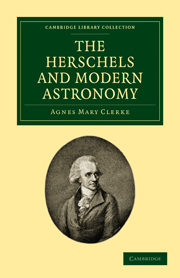Book contents
- Frontmatter
- PREFACE
- Contents
- ILLUSTRATIONS
- CHAPTER I EARLY LIFE OF WILLIAM HERSCHEL
- CHAPTER II THE KING'S ASTRONOMER
- CHAPTER III THE EXPLORER OF THE HEAVENS
- CHAPTER IV HERSCHEL'S SPECIAL INVESTIGATIONS
- CHAPTER V THE INFLUENCE OF HERSCHEL'S CAREER ON MODERN ASTRONOMY
- CHAPTER VI CAROLINE HERSCHEL
- CHAPTER VII SIR JOHN HERSCHEL AT CAMBRIDGE AND SLOUGH
- CHAPTER VIII EXPEDITION TO THE CAPE
- CHAPTER IX LIFE AT COLLINGWOOD
- CHAPTER X WRITINGS AND EXPERIMENTAL INVESTIGATIONS
- INDEX
- Plate section
CHAPTER IV - HERSCHEL'S SPECIAL INVESTIGATIONS
Published online by Cambridge University Press: 05 October 2010
- Frontmatter
- PREFACE
- Contents
- ILLUSTRATIONS
- CHAPTER I EARLY LIFE OF WILLIAM HERSCHEL
- CHAPTER II THE KING'S ASTRONOMER
- CHAPTER III THE EXPLORER OF THE HEAVENS
- CHAPTER IV HERSCHEL'S SPECIAL INVESTIGATIONS
- CHAPTER V THE INFLUENCE OF HERSCHEL'S CAREER ON MODERN ASTRONOMY
- CHAPTER VI CAROLINE HERSCHEL
- CHAPTER VII SIR JOHN HERSCHEL AT CAMBRIDGE AND SLOUGH
- CHAPTER VIII EXPEDITION TO THE CAPE
- CHAPTER IX LIFE AT COLLINGWOOD
- CHAPTER X WRITINGS AND EXPERIMENTAL INVESTIGATIONS
- INDEX
- Plate section
Summary
Double stars were, when Herschel began to pay attention to them, regarded as mere chance productions. No suspicion was entertained that a real, physical bond united their components. Only the Jesuit astronomer, Christian Mayer, maintained that bright stars were often attended by faint ones; and since his observations were not such as to inspire much confidence, his assertions counted for very little. “In my opinion,” Herschel wrote in 1782, “it is much too soon to form any theories of small stars revolving round large ones.” He, indeed, probably even then, suspected that close equal stars formed genuine couples; but he waited, if so, for evidence of the connection. The chief subject of his experiments on parallax was Epsilon Boötis, an exquisitely tinted, unequal pair. But he soon became aware that either stellar parallax was elusively small, or that he was on the wrong track for detecting it. And, since his favourite stars have proved to be a binary combination, it was, of course, drawing water in a sieve to make one the test of perspective shifting in the other.
The number of Herschel's double stars alone showed them to be integral parts of an express design. Such a crop of casualties was out of all reasonable question.
- Type
- Chapter
- Information
- The Herschels and Modern Astronomy , pp. 75 - 97Publisher: Cambridge University PressPrint publication year: 2010First published in: 1895

